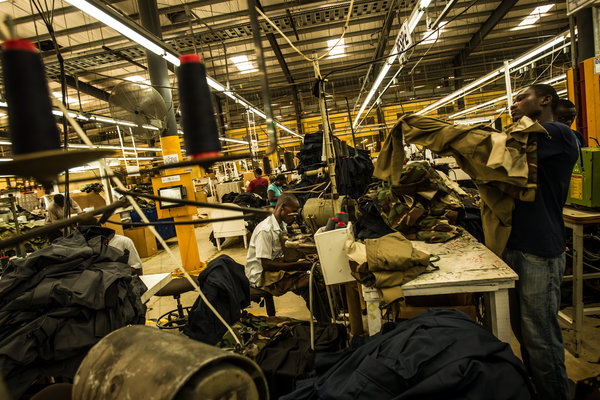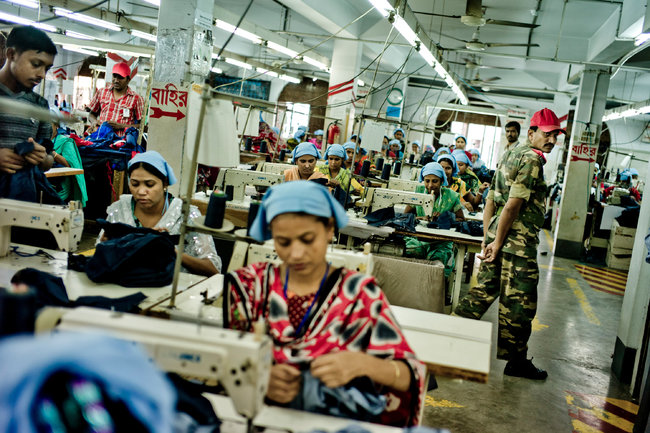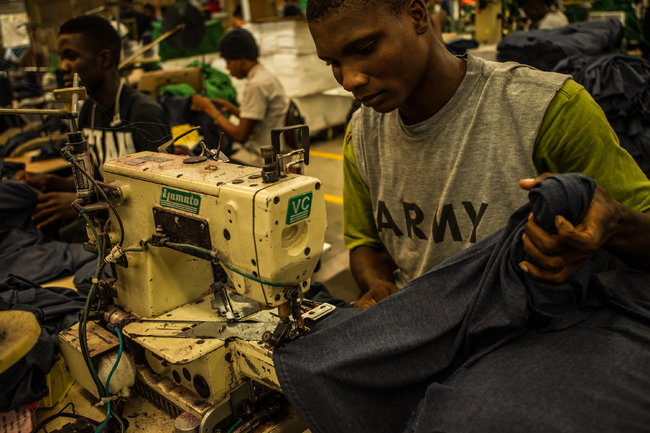Buying Overseas Clothing, U.S. Flouts Its Own Advice
|
But even though the Obama administration has called on Western buyers to use their purchasing power to push for improved industry working conditions after several workplace disasters over the last 14 months, the American government has done little to adjust its own shopping habits.
Labor Department officials say that federal agencies have “zero tolerance” for using overseas plants that break local laws, but American government suppliers in countries including Bangladesh, the Dominican Republic, Haiti, Mexico, Pakistan and Vietnam show a pattern of legal violations and harsh working conditions, according to audits and interviews at factories. Among them: padlocked fire exits, buildings at risk of collapse, falsified wage records and repeated hand punctures from sewing needles when workers were pushed to hurry up. |
In Chiang Mai, Thailand, employees at the Georgie & Lou factory, which makes clothing sold by the Smithsonian Institution, said they were illegally docked over 5 percent of their roughly $10-per-day wage for any clothing item with a mistake. They also described physical harassment by factory managers and cameras monitoring workers even in bathrooms.
At Zongtex Garment Manufacturing in Phnom Penh, Cambodia, which makes clothes sold by the Army and Air Force, an audit conducted this year found nearly two dozen under-age workers, some as young as 15. Several of them described in interviews with The New York Times how they were instructed to hide from inspectors.
“Sometimes people soil themselves at their sewing machines,” one worker said, because of restrictions on bathroom breaks.
Federal agencies rarely know what factories make their clothes, much less require audits of them, according to interviews with procurement officials and industry experts. The agencies, they added, exert less oversight of foreign suppliers than many retailers do. And there is no law prohibiting the federal government from buying clothes produced overseas under unsafe or abusive conditions.
“It doesn’t exist for the exact same reason that American consumers still buy from sweatshops,” said Daniel Gordon, a former top federal procurement official who now works at George Washington University Law School. “The government cares most about getting the best price.”
Frank Benenati, a spokesman for the Office of Management and Budget, which oversees much of federal procurement policy, said the administration has made progress in improving oversight, including an executive order last year tightening rules against federal suppliers using factories that rely on debt bondage or other forms of forced labor.
“The administration is committed to ensuring that our government is doing business only with contractors who place a premium on integrity and good business ethics,” he said.
Labor and State Department officials have encouraged retailers to participate in strengthening rules on factory conditions in Bangladesh — home to one of the largest and most dangerous garment industries. But defense officials this month helped kill a legislative measure that would have required military stores, which last year made more than $485 million in profit, to comply with such rules because they said the $500,000 annual cost was too expensive.
Federal spending on garments overseas does not reach that of Walmart, the world’s biggest merchandiser, which spends more than $1 billion a year just in Bangladesh, or Zara, the Spanish apparel seller, but it still is in a top tier that includes H & M, the trendy fashion business based in Sweden, Eddie Bauer and Lands’ End, sellers of outerwear and other clothing.
|
Like most retail brands, American agencies typically do not order clothes directly from factories. They rely on contractors. This makes it challenging for agencies to track their global supply chain, with layers of middlemen, lax oversight by other governments, few of their own inspectors overseas and little means of policing factories that farm out work to other plants without the clients’ knowledge. When retailers, labor groups or others inspect these factories, the audits often understate problems because managers regularly coach workers and doctor records.
The United States government, though, faces special pressures. Its record on garment contracting demonstrates the tensions between its low-bid procurement practices and high-road policy objectives on labor and human rights issues. |
Along a dirt road in Gazipur, about 25 miles north of the Bangladeshi capital, riot police fired tear gas shells, rubber bullets and sound grenades in a fierce clash with garment workers last month, sending scores to the hospital. The protesters demanding better conditions included some from a factory called V & R Fashions. In July, auditors rated that factory as “needs improvement” because workers’ pay was illegally docked for minor infractions and the building was unsafe, illegally constructed and not intended for industrial use.
Unsafe and Repressive
Like dozens of oth
er factor
ies in the area, V & R makes clothes for the American government, which is constantly prowling for the best deals. In interviews, workers at a half-dozen of these suppliers described the effect of such cost pressures.
At Manta Apparels, for example, which makes uniforms for the General Services Administration, employees said beatings are common and fire exits are kept chained except when auditors visit. The local press has described Manta as one of the most repressive factories in the country. A top labor advocate, Aminul Islam, was organizing there in 2010 when he was first arrested by the police and tortured. In April 2012, he was found dead, a hole drilled below his right knee and his ankles crushed.
Several miles from Manta, 40 women from another supplier, Coast to Coast, gathered late one night to avoid being seen publicly talking to a reporter. Dressed in burqas, the women said that prices of the clothing they make for sale on American military bases are now so cheap that managers try to save money by pushing them to speed up production. In the rush, workers routinely burn themselves with irons, they said, often requiring hospitalizations.
Work does not stop, they said, when it rain pours through a six-foot crack in the ceiling of the top floor of the factory — a repurposed apartment building with two extra floors added illegally to increase capacity. Even after the manager swipes their timecards, they say, he orders them to keep sewing.
While giving a tour of the plant, the manager described the building crack as inconsequential and too expensive to repair. He denied the workers’ other allegations. The owner of Manta declined to comment.
Conditions like those are possible partly because American government agencies usually do not know which factories supply their goods or are reluctant to reveal them. Soon after a fire killed at least 112 people at the Tazreen Fashions factory in Bangladesh in November 2012, several members of Congress asked various agencies for factory addresses. Of the seven agencies her office contacted, Representative Carolyn Maloney, Democrat of New York, said only the Department of the Interior turned over its list.
Over the summer, military officials told Representative George Miller, Democrat of California, that order forms for apparel with Marine Corps logos had been discovered in Tazreen’s charred remains but that the corps had ties to no other Bangladeshi factories. Several weeks later, the officials said they were mistaken and had discovered a half-dozen or so other factories producing unauthorized Marine Corps apparel. On Sunday, the owners of Tazreen and 11 employees were charged with culpable homicide.
President Obama has long pushed for more transparency in procurement. As a senator, he sponsored legislation in 2006 creating the website USASpending.gov, which open-government advocates say has made it far easier to track federal contracting. However, procurement experts fault the website for requiring agencies to name their contractors, but not identifying the specific factories doing the work. Some states and cities already require companies to disclose that information before awarding them public contracts, said Bjorn Skorpen Claeson, senior policy analyst at the International Labor Rights Forum.
Federal officials still have to navigate a tangle of rules. Defense officials, for instance, who spend roughly $2 billion annually on military uniforms, are required by a World War II-era rule called the Berry Amendment to have most of them made in the United States. In recent years, Congress has pressured defense officials to cut costs on uniforms. Increasingly, the department has turned to federal prisons, where wages are under $2 per hour. Federal inmates this year stitched more than $100 million worth of military uniforms.
No sooner had the Transportation Security Administration, or T.S.A., signed a $50 million contract in February for new uniforms for its 50,000 airport security agents and other workers, than the agency was attacked from all sides.
Union officials, opposed to outsourcing work overseas, objected because the Mexican plant making the clothing, VF Imagewear Matamoros, was the same one that had treated uniforms with chemicals that caused rashes in hundreds of T.S.A. agents. Congress called an oversight hearing, where some lawmakers questioned why two-thirds of the uniforms would be made in foreign factories, saying the deal was a missed chance to stimulate domestic job growth. Other lawmakers faulted the agency for spending too much money on clothing, especially on the cusp of a federal budget crisis, no matter where the merchandise was made.
“Bottom line,” John W. Halinski, T.S.A. deputy administrator, told Congress, “we go for the lowest-cost uniform, sir.”
The hunt for lower costs and the expansion of free-trade pacts have meant that more of this work is being done abroad, often in poor countries where the Obama administration is trying to spur competition and development.
In Haiti, for instance, trucks loaded with camouflage pants, shirts and jackets, some of them destined for American military bases, idle in front of a factory called BKI.
Next year, BKI managers hope to double the amount of camouflage clothing made for the American government, part of a contract worth more than $30 million between a division of Propper International, a Missouri-based uniform company, and the General Services Administration, which outfits workers for more than a dozen federal agencies.
Three years ago, much of this camouflage clothing was made in Puerto Rico, where workers earned the minimum wage of about $7.25 an hour. By 2011, many of these jobs moved to a factory in the Dominican Republic called Suprema. Wages there were about 80 cents per hour and unpaid overtime was routine, according to workers in recent interviews and a 2010 audit. Since then, most of these jobs have migrated again, this time to BKI in a Haitian free-trade zone called Codevi. Average hourly wages at BKI are about 8 cents less per hour than those at Suprema, according to workers.
Standing near the factory entrance, several BKI workers said they were proud of the clothes they made for the American government. “We push hard because we know they expect better,” said Rodley Charles, 29, a quality inspector at the factory.
But there is basic math: the average pay of 72 cents per hour (which is illegal and below Haiti’s minimum wage) barely covers food and rent, said Mr. Charles, who has since quit, and two other BKI workers.
These wage pressures may soon intensify. Codevi will soon face new competition from another industrial park called Caracol, which is being built partly with money from the United States Agency for International Development as part of reconstruction efforts after the earthquake of 2010.
American officials predict that Caracol will eventually create 60,000 new jobs. Current wages there? About 57 cents per hour, or roughly 15 cents less than typical wages at Codevi.
Big Business
At a military store in Bethesda, Md., Tori Novo smiled as she looked over a pair of $19.99 children’s cargo pants made in Bangladesh that sell for $39 in most department stores. The best part of living on base, said Ms. Novo, a 31-year-old Navy recruiter, was “savings like these.”
Known as exchanges, these big-box stores on military bases around the world offer a guarantee: to beat or match any price from rivals. That promise puts the exchanges in direct competition with the deep discounts offered by stores like Gap and Target. It also adds to already intense pressure to lower costs by using the cheapest factories, industry analysts say.
These stores, run by the Defense Department, do big business, selling more than $1 billion a year in apparel alone. Exempt from the Berry Amendment, the exchanges get more than 90 percent of their clothes from factories outside the United States, according to industry estimates. The profits from these tax-free stores mostly go toward entertainment services like golf courses, gyms and bowling alleys on bases.
Though the Government Accountability Office criticized the exchanges over a decade ago for exerting less oversight than private retailers and for failing to independently monitor their overseas suppliers, little has improved.
The Marine Corps and Navy still do not require audits of these factories. The Air Force and Army exchanges do, but the audits can come from retailers, and defense officials fail to do routine spot checks to confirm their accuracy.
For example, Citadel Apparels, a factory in a seven-story building in Gazipur, has cut, stitched and shipped more than 11 metric tons of cotton boys’ T-shirts and other clothes for sale at exchanges on Army and Air Force bases in recent months. This summer, lawmakers in Congress asked the Defense Department for proof that Citadel was safe. Defense officials produced an audit conducted for Walmart, another client of the factory, showing that it had an “orange” risk ranking in July 2012, the same high level of alarm that Walmart had given the Tazreen factory before the fatal fire there last year.
While allowing the factory to stay open, the audit offered an alarming statistical snapshot.
Sixty-five percent: number of workers barefoot, some on the building’s roof. Fifty percent: workers without legally required masks to protect against cotton dust. Sixteen percent: workers missing time-sheets, a common sign of forced overtime. Most serious infractions: cracks in the walls that could compromise the building, and partly blocked exit routes and stairwells.
By January, Citadel’s auditors concluded that most of these dangers had been fixed. However, a half-dozen Citadel workers offered a starkly different picture. Virtually none of the original problems had ever been corrected, they said in interviews last month with The Times.
“We aren’t sewing machines,” one worker said. “Our lives are worth more.”
For now, Bangladesh’s garment sector continues to grow, as do purchases from one of its bulk buyers. In the year since Tazreen burned down, American military stores have shipped even more clothes from Bangladesh.
Ian Urbina reported from Bangladesh and Washington. Research was contributed by Susan Beachy in New York, Poypiti Amatatham in Bangkok, Karla Zabludovsky in Mexico City, Malavika Vyawahare in New Delhi and Meridith Kohut in Ouanaminthe, Haiti.





Leave a Reply
Want to join the discussion?Feel free to contribute!